| |
Contra Costa Times editorial: Chevron once again lacks candor critical for gaining the trust of residents
Contra Costa Times editorial © 2014 Bay Area News Group
Posted: 12/19/2014 06:54:20 PM PST0 Comments | Updated: about 2 hours ago
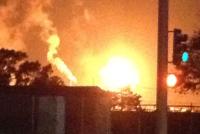
(Contra Costa College Advocate)
Related Stories
As flames visible for miles shot from flares at the Chevron refinery on Thursday night, residents of the East Bay wondered whether the facility was once again on fire.
Chevron officials apparently wanted to assure the community that it was not, that this wasn't a repeat of the 2012 inferno that nearly killed 19 workers, spewed tons of pollutant-laced black smoke into the air for hours, sent 15,000 seeking medical attention and hospitalized about 20.
But, once again, the company lacked the candor critical for gaining the trust of residents. In its first statement, issued about an hour after the flaring began, the company said, "There was some visible flaring tonight to allow for equipment de-pressuring. Flaring is a normal part of refinery operations."
That's like saying after a car accident that deployment of air bags is a normal part of automobile operations.
The flaring was a normal response to a situation that was anything but normal. Dangerous pressure had apparently built up in the solvent deasphalting unit, an early stage in the gasoline production process. The flaring was the emergency solution.
Throughout the night and the following morning, Chevron continued to echo the word "normal" in subsequent statements. They elaborated that a unit needed to be "depressurized" and that safety systems were working as designed.
But they never added the important element. None of this was part of routine operations. Something had apparently gone wrong -- again. County officials later called it a "near miss."
The company refused to say why the unit needed to be depressurized. A spokesman claimed they do not publicly discuss refinery operations. That's ridiculous.
That sort of obfuscation only exacerbates the situation. "The denial of what happened can actually make things worse," says county Supervisor John Gioia, whose district includes the refinery.
"Rather than trying to correct it they're trying to deny it. The denial shows a lack of wanting to create trust within the community."
It couldn't come at a worse time for the company. Not only does the memory of the 2012 fire still loom large, city residents just survived the company's attempt to buy the mayoral and City Council elections by spending $72 per registered voter on a sleazy campaign of half-truths.
Chevron's credibility in Richmond might be at an all-time low. Yet, the company keeps digging a deeper hole for itself. Popular lore has it that the first rule of holes is that when you find yourself in one, you should stop digging. It's time for Chevron to stop digging; it's time for candor with the community.
East Bay Chevron refinery incident draws criticism, raises concerns about emergency-response capabilities
By Robert Rogers rrogers@bayareanewsgroup.com
Posted: 12/19/2014 05:14:15 PM PST4 Comments
Updated: 12/20/2014 08:26:39 AM PST
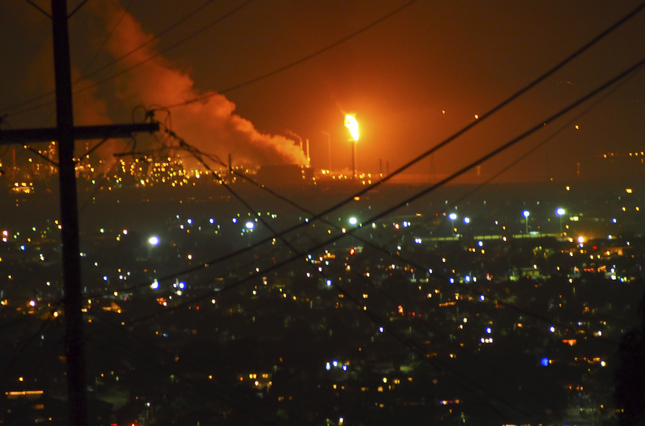
Flames are seen at the Chevron Richmond Refinery during the evening hours Dec.18, 2014 in Richmond. (Chris Treadway/Bay Area News Group)
Related Stories
RICHMOND -- Speculation grew Friday about whether the fire in the sky that emanated from Chevron's Richmond refinery on Thursday night was a "near miss" that easily could have resulted in a catastrophic accident on par with the massive blaze at the facility two years ago.
The August 2012 accident sparked a federal investigation and sent thousands of residents to the hospital -- stretching a local health care network that is far less equipped to deal with such an emergency today.
But Chevron insisted that the new flaring incident -- which sent lashing orange flames and smoke into the air that were visible for miles, had no effect on public health and that its safety systems worked as designed to contain the problem.
Contra Costa County Supervisor and Bay Area Air Quality Management District board member John Gioia criticized Chevron's characterization, and called the multistory fireball a "likely near miss" and a "flag that something went wrong."
"Chevron downplaying the seriousness of this is not in the public interest," Gioia, a Richmond resident, said Friday. "It's better to say something happened, and we're handling it. Characterizing it as normal operations or normal flaring is not an accurate representation."
Residents took to social media in droves to post pictures and seek information, reprising memories of the refinery's last major accident, which resulted from a corroded pipe and sent more than 15,000 people to area hospitals in the ensuing weeks, mostly complaining of minor respiratory discomfort.
"Flares are found at all Bay Area refineries and are safety devices that burn pollutants that would otherwise be directly released to the atmosphere," the air quality district said in a statement. "Flaring may result from the startup and shutdown of units or during accidents or upsets."
Denny Larson, executive director of local environmental group Global Community Monitor, said the size of Thursday's incident, which he believes consisted of flares flowing from four valves, indicates that tremendous pressure had built up.
"They probably tweaked the controls to change the mix to try to get it under control but couldn't get a handle on it and had to depressurize," Larson said. "Without the capacity, the four (valves releasing) flares, the unit could have faced a catastrophic explosion."
It also raised the specter of a major public health emergency in West Contra Costa, an area that is home to hundreds of thousands of residents but contains just 40 emergency room beds and could soon have only 15 if Doctors Medical Center in San Pablo is forced to close because of mounting financial problems. DMC was inundated with patients after the 2012 fire, and now has less than half the capacity it had then, because of budget cuts.
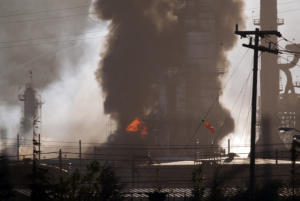
Smoke and flame billow from a crude oil unit at the Chevron refinery in Richmond, Calif., Monday, Aug. 6, 2012. (D. Ross Cameron/Staff Archives) ( D. ROSS CAMERON )
According to a 2012 county Health Services Department report, DMC sought volunteer physicians, nurses and other workers to deal with the surge of patients in the days after the fire -- many of whom arrived after Chevron announced a program to compensate residents for medical claims.
"Being in such close proximity to (a refinery) that has the potential to have a major event could create a real challenge in terms of trying to get people to timely emergency care," county Emergency Medical Services Director Pat Frost said Friday. "We would have to rely on our mutual aid network with agencies outside the county, and if we didn't have DMC, wait times would be longer."
Chevron spokesman Braden Reddall on Friday declined to address Gioia's contention that the flaring was a "near miss."
"The flaring last night was the safety mechanism working as it should," he said. Reddall said the flare began at 6:35 p.m. and ended at 7:52 p.m., with "intermittent" flaring after.
Reddall declined to say when the unit would come back online but said there would be no effect on production. "We're supplying the market as normal," he said. A statement released by the air district Friday morning provided more detail, saying that a "plant upset" occurred in the refinery's solvent deasphalting unit.
"The flaring subsided at approximately 10:20 p.m.," the statement said.
Mayor-elect Tom Butt posted a photo of the flames on Facebook and wrote, "This is the biggest flaring I have seen at Chevron in years."
Photos from as far as Oakland and Berkeley showed a towering fireball visible above the city scape of residential lights.
Gioia, a lifelong East Bay resident who was on a train from an air board meeting in Sacramento on Thursday night, said the photos he saw showed "the most visible flaring I have ever seen." Gioia added that the air district will require Chevron to provide a causal analysis of the incident within 30 days.
The county's Hazardous Materials Department and the air district said they will investigate the incident.
Randy Sawyer, Contra Costa County's chief environmental health and hazardous materials officer, said he dispatched inspectors to the refinery Thursday and requested that the refinery provide a report within 72 hours detailing what happened, which it produced Friday afternoon. He said air monitors in nearby communities Atchison Village, North Richmond and Point Richmond indicated elevated particulate matter but not at dangerous levels, and that the fallout could not yet be definitively attributed to the flaring.
A website that feeds real-time air quality data of fence line communities showed low readings of ammonia, hydrogen sulfide and black carbon.
Sawyer agreed with Gioia's characterization of the flaring as a "near miss."
"Some piping got plugged, and it built up pressure," Sawyer said. "The automated pressure-release devices pop open when you have an unplanned upset, so it went off as designed. If something didn't go right, there could have been a compromise of the process."
While flaring is a normal part of the refinery's operations, and happens less frequently than it did decades ago, large flares continue to draw attention. On Nov. 25, a daytime flare alarmed residents and prompted Chevron to issue a similar statement, calling it a "no impact" event.
The air district is also investigating that flare.
Contact Robert Rogers at 510-262-2726. Follow him at Twitter.com/sfbaynewsrogers. |
|
|
|
Chevron submits air quality report following flare-up
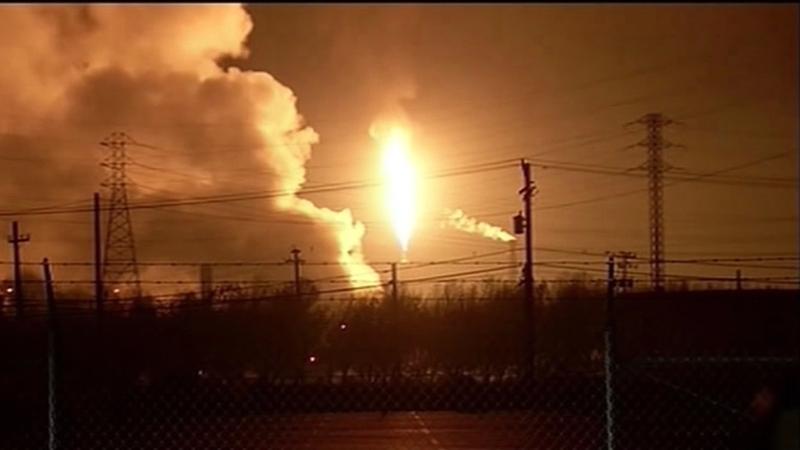
Chevron's report to the Contra Costa Health Services Department shows no toxins were released into the air following Thursday night's flare-up.

By Laura Anthony
Friday, December 19, 2014 10:51PM
RICHMOND, Calif. (KGO) --
Residents who remember the big fire of 2012 at the Richmond refinery, were alarmed at Thursday night's fire when the dark sky was lit up by a giant flame coming from the very same facility.
And while Chevron is downplaying the incident, critics say the company didn't handle it well.
Chevron spokesman Kurt Glaubitz says the flaring wasn't planned, but he also wouldn't call it an emergency.
"It's important for the community to know what the community saw out there last night was really the safety systems at work. It's part of the natural safety systems we have in place at the refinery," said Glaubitz. "What was burning off was excess fuel in the unit. We were depressurizing the unit, making sure it was brought down safely."
RAW VIDEO: Flaring operation at Richmond refinery
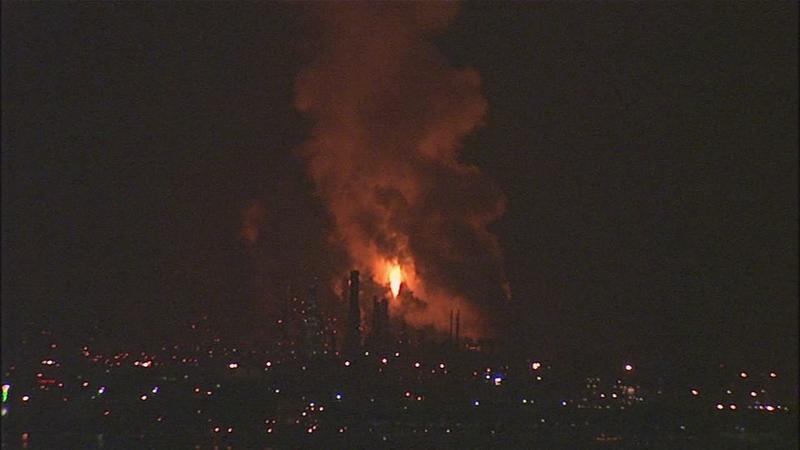
In fact, Chevron has provided the Contra Costa Health Services Department with a report on Thursday night's flaring event.
In addition, the Richmond Community Air Monitoring Program has released a summary of the data captured during the flaring. Chevron says the report shows that the fence line monitoring equipment indicated no detection of gases outside the normal concentration ranges seen in urban environments. The Contra Costa County Department of Health said the fence line measurements of particulate matter around the refinery did elevate during the flare, but not enough to exceed state or federal limits.
Still, many in the community are not satisfied with how the events played out.
"I'm disappointed Chevron downplayed the seriousness of what happened," said Conta Costa Supervisor John Gioia, who also sits on the board of the Bay Area Air Quality Management District.
Gioia says the environmental impacts from the event are one thing, but he's almost more concerned about Chevron's response.
"This was not normal flaring. This was flaring related to a problem at a unit. Anyone looking at it could determine it was well above the level you would normally see," stated Gioia.
The deasphalting unit that experienced the problem has been shut down. Both Chevron and the Air Quality Management District will investigate the incident.
Meanwhile, skeptical residents still have doubts and fears.
"It looked like it was spewing liquid. It was coming down and cascading down the pyke and it was just burning and falling," said Matthew Carmona, a Richmond resident.
Residents say they did not receive any kind of notification from Chevron about what was going on.
The company did release a written statement to the media saying: "There has been no impact to the community and the refinery fence lines monitors are showing that the air quality is well within quality standards."
Contra Costa County health officials said in a statement on Twitter that a hazardous materials team was on scene but the event did not require a shelter-in-place.
"They have that there to control the massive PR situation," said Shy Simmons, also a resident, of Chevron's media statement.
Mayor-elect Tom Butt says that's a problem that needs addressing.
"I don't think we have a health issue here. We do have an issue of informing the public of what's going on," he said.
Butt says he didn't hear from Chevron until two hours after the flare started burning. His public health experts assured him that air quality had not been impacted, but he says people need to know what's happening right away.
"It's just not right to scare people like that and let them hang-around a couple hours and wonder what's going on. We've got to find some way to get ahead of that," said Butt.
Contra Costa County Supervisor John Gioia tweeted out that flare gases at Chevron include hydrocarbons, carbon dioxide, particulate matter and other compounds and that Hazmat inspectors were on scene and monitoring.
Flames and water vapor became visible when a process unit at the refinery needed to be depressurized and shut down, according to Chevron spokesman Braden Reddall.
"The process produces a flare, and water vapor that looks like smoke, and makes it possible to shut down the unit safely," Reddall said.
Reddall said fence line air quality monitors showed no impact to the community. He added that he could not discuss why the unit needed to be depressurized due to the "commercial sensitivity" of refinery operations.
The director for the Global Community Monitor said data from those same monitors shows high levels of fine particulate matter, which is unhealthy for people.
"The majority of the wind direction is blowing out over the bay, so it's not impacting the community of North Richmond," Marioka said.
ABC7 News reporter Amy Hollyfield and Bay City News contributed to this report
|
|

